NOW THAT APRIL’S HERE
In “Lines from Abroad,” English poet Robert Browning wistfully mused: “Oh to be in England, now that April’s there.” Like Browning, I readily understand homesickness, especially that associated with seasons of the year, no matter what place one might call home. After all, who can deny the appeal of a sunny day’s walk when wildflowers begin to bloom with their spring abundance or the sheer delights of a day of bluebird skies and gentle breezes during an Indian Summer day heralding the arrival of fall? For that matter, in my mind at least, there’s enduring appeal to be found in a summer evening on a porch, with beans to be strung or maybe just savoring any breath of air that breaks the humidity. Likewise, a winter day of soft snow, with the earth wrapped in a robe of white, will always tickle my fancy.
Speaking of homesickness, the first semester of my freshman year in college I was so homesick it’s a good thing the institution (King College, now King University, in Bristol, TN) had a schedule that in effect no one other than students living quite close by could go home until Christmas. That was in an era when a college student owning a car, at least among the economic class to which my family belonged, was virtually unknown. Likewise, you simply didn’t miss class. That translated to no weekend returns to my beloved highland homeland in N. C.’s Great Smokies, and I missed squirrel and rabbit hunting and the familiar confines of home in a fashion that was almost painful. Part of that was no doubt the result of a boyhood where I seldom was away from home except to spend the night at some buddy’s house, not to mention being a stranger to things like hotel stays, summer vacations, and more. I first saw the ocean at the age of 25 and had set foot in exactly five states (if you counted three or four hours in Maryland in the course of a senior class trip to Washington, DC and a side jaunt to Glen Echo Park). Mind you, once I discovered the allure of two women’s colleges in Bristol and the draw of the golf course belonging to King, the homesickness went away.
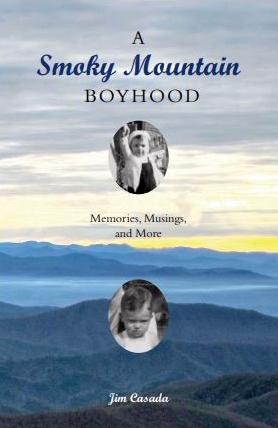
I’ve wandered a bit, as I’m decidedly prone to do, but if you’d like a great deal more about what I now realize was an absolutely magical boyhood, information aplenty is available in an award-winning autobiography I wrote about growing up. That book, A Smoky Mountain Boyhood: Musings, Memories, and More, is this month’s special offer. Signed and inscribed copies are available for $25, postpaid, by ordering directly from me (Jim Casada, 1250 Yorkdale Drive, Rock Hill, SC 29730). No PayPal orders on this one please, just checks, cash, or money orders. If you read the book I’ll think you’ll discover that mine was a youth to envy. We might have been passing poor, but there was always food on the table, adequate clothing, a loving family, close community, and more. We ate meals together, we knew the meaning of hard work and thrift, we were part of a close-knit church congregation, and school teachers were interested in education rather than indoctrination.
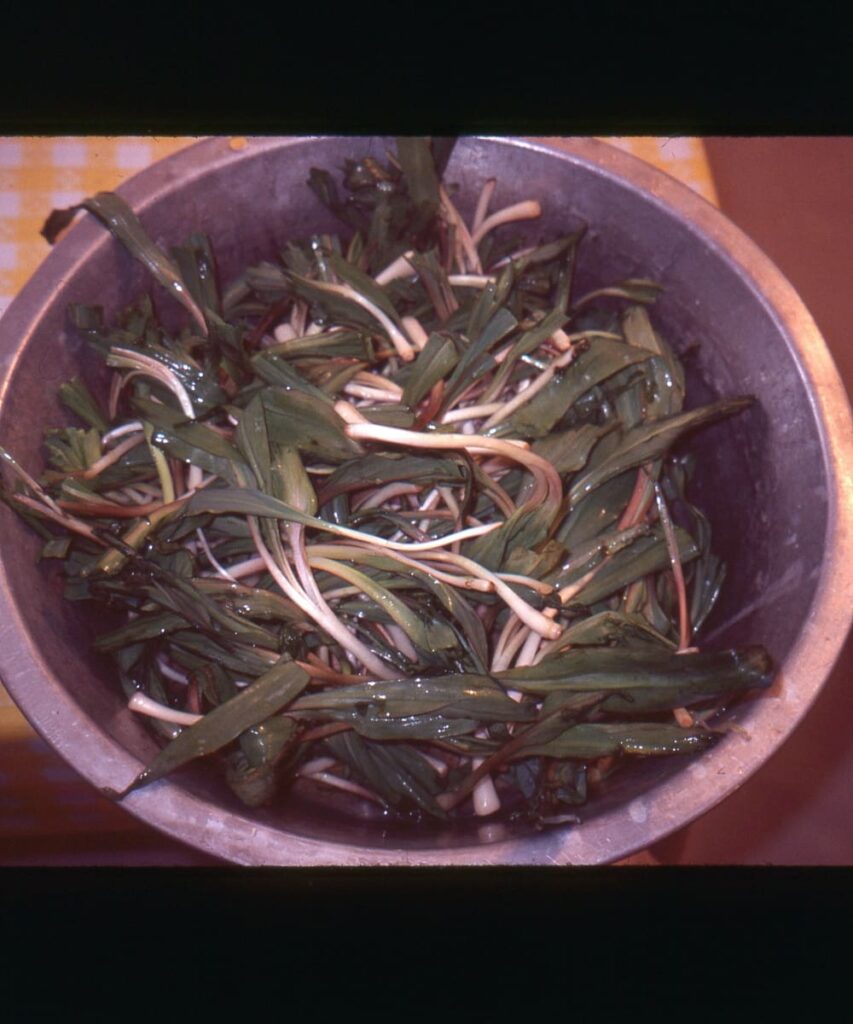
Now, back to April. The month provides a plentitude of fond recollections. It was a time of blooming wild flowers at their best (the Smokies where I grew up have the greatest biological diversity found anywhere in the Northern Hemisphere, and the blooms of spring are a time of glory), the opening day of trout season, a mess or two of poke sallet (which in addition to being delicious was a purgative that, in Grandpa Joe’s description, would “set you free”), enforced spring tonics in the nauseous form of sulfur and molasses AND sassafras tea (that particular memory is not one to cherish, but it most assuredly remains), “kilt” ramps and branch lettuce on camping trips into the backcountry, and the sheer joy of being out and about in a natural world going through its annual rebirth. It was getting in potatoes, early peas, lettuce, and other cool weather crops as soon as the ground was dry enough to work, and how I loved the old black man who came around each year with his team of horses to do our plowing. I would watch, fascinated, as he maneuvered the equines with a skill born of long practice, and each “gee,” “haw,” and “whoa” tickled my fancy. Incidentally, as was the case with so much mountain property, plowing the lower garden would have been a non-starter for modern equipment. It was far too steep, but horses and old Mr. Powell handled matters quite nicely.
April also brings back memories of what was quite possibly the most enjoyable school task I ever undertook. My 10th grade biology teacher was an affable fellow named Clifford Frizzell, and at some point early in his career he came up with a stroke of sheer pedagogical genius or possibly just followed up on a practice initiated by his predecessor in the position who was an aunt of mine. Whatever its precise origins, the major project for the spring semester was to venture into the hills and hollows of the high country and find as many different plants as possible. You were expected to “press” a leaf or flower, give the plant’s common and scientific names, and extra credit could be earned through describing any uses the plant had for humans. For a youngster who cherished every minute he was outdoors, the assignment was a godsend.
I don’t remember how many plants I gathered, but the total ran to many scores of them. Even today, more than a half century later, I recall the scientific names of a surprising number (and this was my one and only formal exposure to biology at any educational level). I particularly enjoyed learning about the human uses of plants, and of course Daddy and Grandpa, both of whom were first-rate amateur naturalists, were of great help. There were foodstuffs aplenty—all the wild fruits, nuts, and berries; wild vegetables such as those mentioned above along with lamb’s quarters, dandelion greens, and a bunch more; medicinal plants such as yellow root and ginseng; and virtually every tree had one or more practical applications. Even non-timber trees such as dogwoods (for slingshots and a perfectly serviceable wedge for splitting wood), elderberry shoots (pop guns, blow guns, whistles, and turkey calls), and Osage orange (bows, yokes) had their applications.
Daddy made me a nice binder with varnished wooden backs to hold the pages, each with a pressed leaf or flower along with the necessary write-up, and even though I could have been a better scholar than I was, in this particular case I outdid myself. On top of that, Mr. Frizzell had the great goodness, on several occasions over the years, to compliment me on my trout fishing. He lived right alongside Deep Creek, my “home” creek, and in late spring and summer would often watch me for a few minutes. Obviously I remember him with great fondness, and a teacher who implants an impression of the sort I’ve just described is one who has made a meaningful mark.
April also meant the first night crawlering (late in the month after a shower when the weather was fairly warm these giants of the worm world would show up above ground at night), lizard catching, and seining. All were highly desirable fish bait which brought in something I had precious little of—cash money. A local bait and tackle store, once a common part of the small town scene, would buy all I had to offer. I also earned a quarter every time I gathered a #8 poke of poke sallet (I’m not confused here—in the mountain vernacular a poke is a paper bag), and April brought the first opportunities to caddy for local golfers. It was, in short, a month for getting a little jingle in the pocket, because the lean times of winter provided few opportunities to make “cash money.”
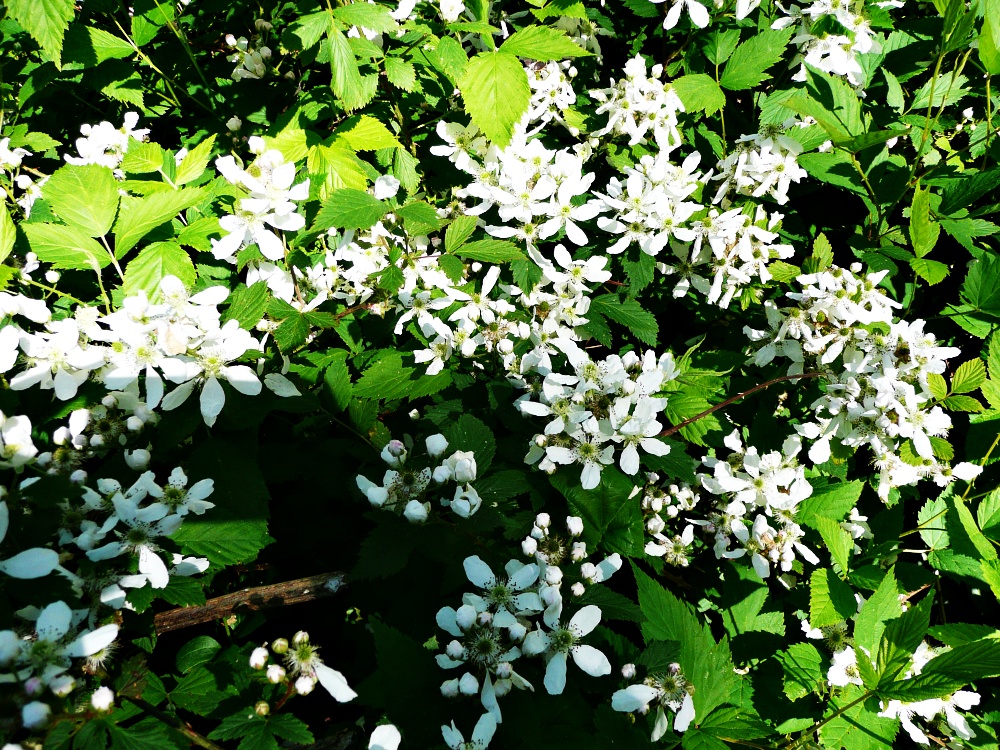
These days my Aprils are rather circumscribed. Advancing age and physical issues related to it have greatly curtailed the turkey hunting that consumed me for decades along with signaling the end to a lifetime of trout fishing. But I’m not so troubled that I don’t notice other things. I take note of the whereabouts of any blackberry patches I come across, and the same is true for persimmon trees and pawpaws. It’s just a force of habit born of a lifetime of close connection to the good earth. Throw in the simple delight of watching courting song birds; the countless sounds of daybreak on a clear, crisp morning; observing a pair of bluebirds building a nest in the box (made by my late father) where generations of them have raised their broods for more than a quarter of a century; and the sheer joy of “greening up” time and I have to reckon that April is, always has been, and always will be one of my favorites.
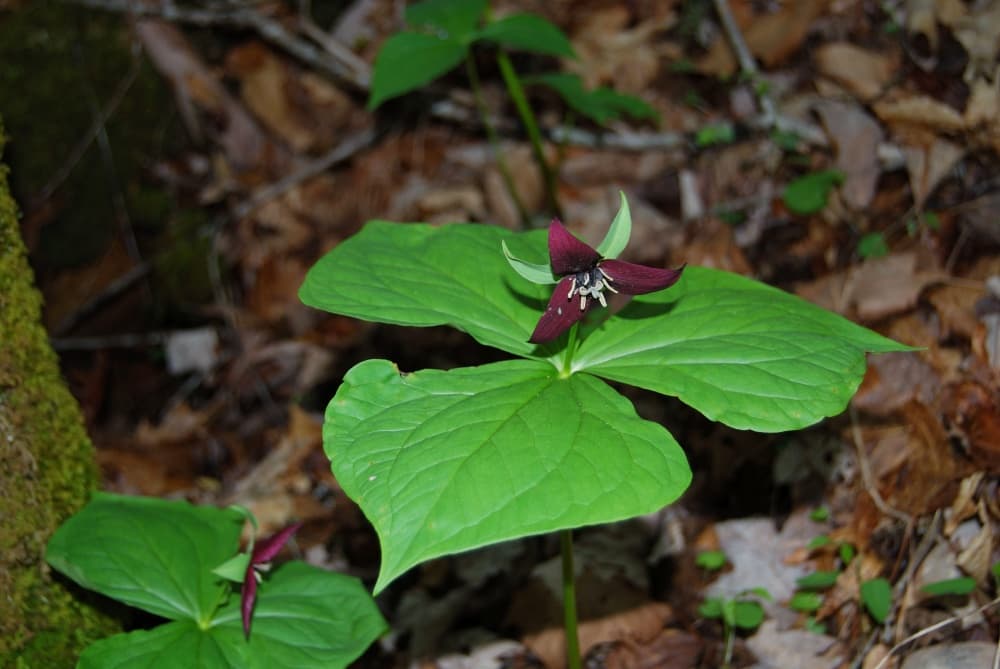
April has other appealing faces as well, many of them simple yet supremely satisfying. Here are a few of the month’s blessings in no particular order than how they come to my admittedly cluttered mind. They are offered in a sort of rapid-fire listing fashion that was a favorite literary gimmick of an old-time North Carolina writer by the name of John Parris.
*April is the joy of eating a mess of ramps in a backcountry campsite.
*It’s finding enough morel mushrooms to fill a basket.
* The first full month of spring is filling a paper poke with a mess of poke.
*April is noting the location of blooming blackberries with plans to return in pickin’ time.
*The month brings the onset of the wonder of woodlands full of wildflowers—half a dozen species of trilliums, bluets, trout lilies, spring beauty, dog hobble, jack-in-the-pulpit, blood root, and countless others.
*April is watching a pair of nesting bluebirds out the kitchen window while eating lunch.
*It’s finding a big batch of branch lettuce (saxifrage) just begging for a dressing of bacon bits and hot grease.
*An enduring April joy is locating an old spring or little branch filled with watercress.
*April is the pure delight of being amidst a heavy hatch on a trout stream with fish rising all around.
*It’s listening to awakening woods while turkey hunting.
*April is observing the seemingly endless shades of green as nature awakens from her winter rest.
*The month is one of the simple delight of walking in the cool mist of daylight or rambling at dusk amidst a thousand hues of green.
JIM’S DOINGS
There’s not a lot to report on the home front for the simple reason I haven’t been overly busy, at least not in a measurably productive way, since last month’s newsletter. I’ve probably spent more work time evaluating and pricing out-of-print sporting books than anything else. These are collections being sold through the Sporting Classics Store. If you’d like to see what is currently on offer, and the listings change regularly as items are sold and new holdings added, visit the Store website and then click the book link followed by clicking on the Rare/Classic books link.
Otherwise I’m reading a lot, something I’ve always done, with my recent forays in this direction involving a heavy diet of books by Jesse Stuart, a great “hillbilly” writer from Kentucky who grew up a son of the Appalachian soil as I did, and a potpourri of mysteries. My manuscript profiling characters of my Smoky Mountain homeland is currently under consideration by a university press and I’m investing at least some time in a couple of other books. Publications in recent weeks include my weekly columns in the local daily newspaper, the Smoky Mountain Times. In them I’m looking at folks I knew as a lad who were, for various reasons, of keen interest to me. Right now that involves a convicted murderer (I didn’t know that about him at the time) who was a sort of Caucasian equivalent of the former slave featured in the wonderful song, “Catfish John,” by Alison Krauss and the Nitty Gritty Dirt Band. Other recent items are “Small Game Was Joy on the Table,” Smoky Mountain Living, Feb./March, 2025, pp. 14-17; “Dreaming of Duxbak Days,” “Sporting Classics Daily,” March 6, 2025; “Turkey Hunting’s Literary Foundations,” Sporting Classics, March/April,2025, pp. 81-83; “Where Have All the Manners Gone?,” Columbia Metropolitan, March, 2025, pp. 74-76; “Zane Grey in Print: A Collector’s Guide,” “Sporting Classics Daily,” Mar. 20, 2025; ”Spring Tonics,” Carolina Mountain Life, Spring, 2025, pp. 118-19; and “Offbeat Mountain Edibles,” Smoky Mountain Living, Apr./May, 2025, pp. 8-11.
RECIPES
STRAWBERRY TRIFLE
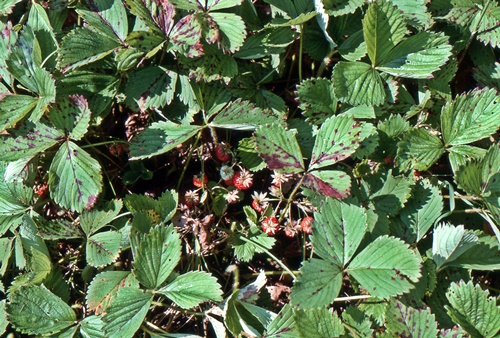
Izaak Walton, somewhere in his writings, quotes a Dr. Boteler on the deliciousness of strawberries: “Doubtless God could have made a better berry, but doubtless God never did.” This is the month to note wild strawberries in bloom, and next month brings them to ripeness over much of the country. They are far better than their tame brethren, but if you don’t have access to the red jewels in the wild, substitute their domestic cousins in this recipe.
1 yellow cake mix, baked according to directions
1 quart wild strawberries (cooked slightly with sugar and a dash or two of Grand Marnier if desired)
3 large vanilla pudding mixes (enough for 6 cups of milk) mixed according to directions
2 large containers whipped topping (24 ounces total)
Cover bottom of large bowl or trifle dish with a layer of crumbled cake. Place a layer of strawberries over cake, followed by a layer of pudding and a layer of whipped topping. Repeat layers twice, ending with whipped topping and reserved fresh berries.
SAUTEED MORELS
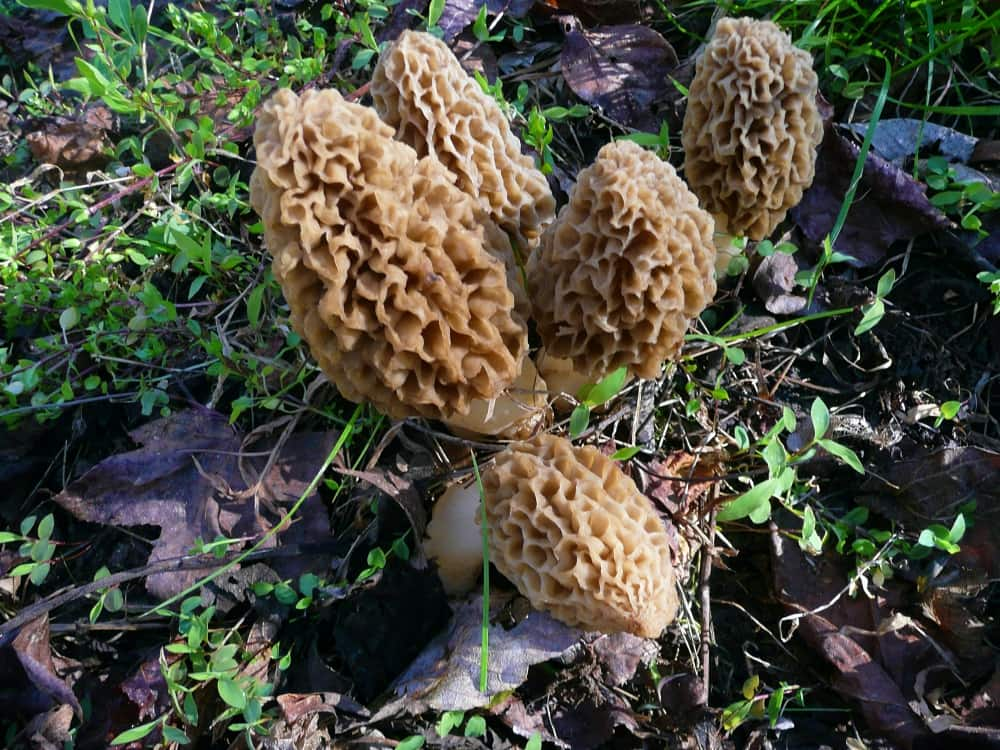
Morel mushrooms are a great delicacy, and I have three favorite ways of preparing them. In each case, soak the mushrooms in salt water and then clean thoroughly. Dab dry with a towel or paper towels and slice in half. It is hard to beat introducing the mushroom pieces to simmering butter in a pan, sautéing until they begin to brown, and eating them right from the pan. Another approach is to beat up a couple of eggs and dip each mushroom piece in the eggs before putting in hot butter to cook. Finally, crumble up saltine crackers, use the same egg dip, but follow with a coating of crushed saltines and then cook. Whatever your choice, it’s food for the gods.
POKE SALLET
Poke shoots are easy enough to find over much of the country. Just be sure to get tender young shoots only three or four inches above the soil’s surface. Clean thoroughly and then bring to a rolling boil in a sauce pan of water. Drain, rinse, fill the pan with water again and repeat the process. Only after two times of cooking and draining are you really ready to get down to business (the plant, without this approach, contains an unhealthy amount of Vitamin A). The third time cook in boiling water yet again, drain, and this time salt and pepper to taste and dig in. Mountain folks often place chopped, boiled eggs atop the sallet or place the cooked greens in a frying pan and scramble eggs with the greens.
KILT RAMPS AND BRANCH LETTUCE SALAD
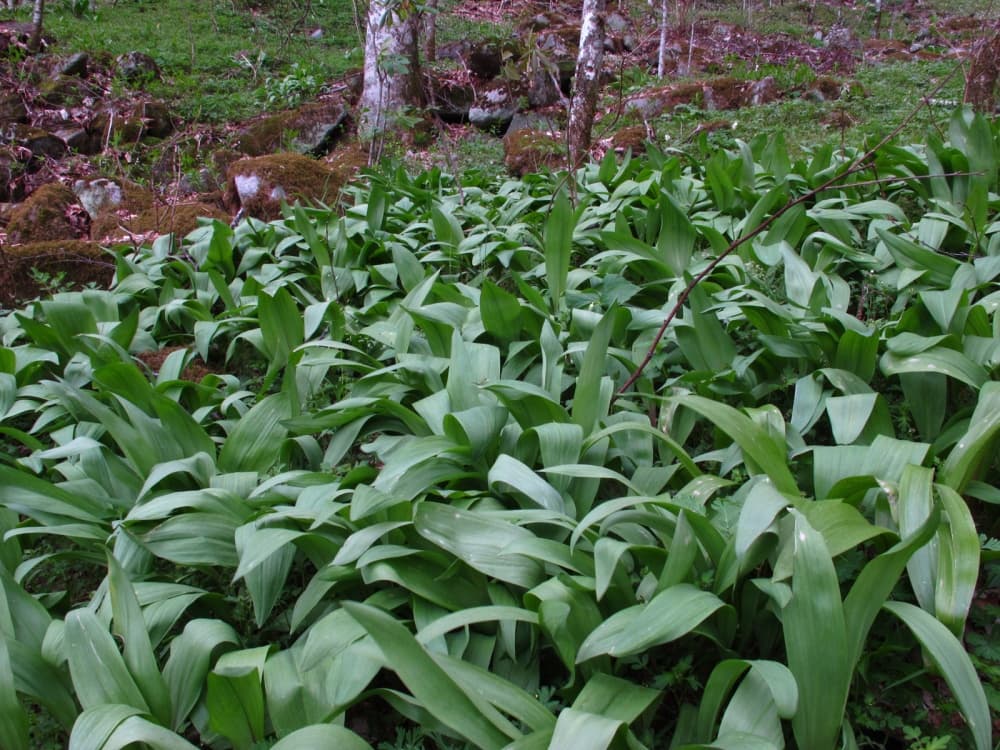
This is a salad I’ve never eaten anywhere except in the wilds, and given the pungency of raw ramps maybe that’s best. However, so long as you aren’t going to be out in public, and provided other members of your household indulge, there’s no reason not to have this delicious dish at home.
Gather a batch of ramps and branch lettuce (saxifrage) and clean thoroughly. Cut the roots off the end of the ramp bulb. Some folks also cut away most of the ramp leaves, although it is edible. Chop up the ramps and tear the branch lettuce leaves into pieces. If by chance you have water cress available, it is a nice addition to the salad as well. Stir lightly to mix lettuce and ramps.
Dress with a “kilt” bacon dressing. To make this, fry a few strips of bacon until crisp, remove and crumble while reserving the hot grease. Reintroduce the crumbled bacon to the grease and pour over the ramps and lettuce. If you happen to be so fortunate, this goes quite nicely with a mess of morels and some pan-fried, freshly caught trout.
An alternative to this, and it probably lies more readily in the availability and appeal levels of most of you, is a simple “kilt salad.” Just combine lettuce with some spring onions and maybe sliced radishes, crumble bacon bits atop it, and use some of the hot grease from frying the bacon as your dressing. It makes some mighty fine eating.